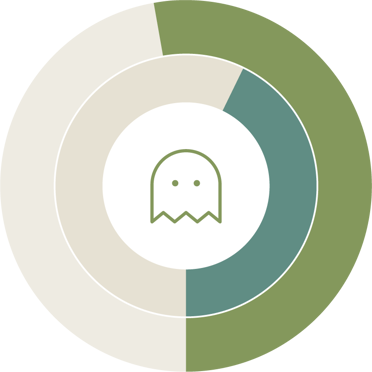What is Deepfake fraud in accounts payable, and how can you prevent it?
In a recent blog post, Top challenges for accounts payable and finance professionals in 2024, we shared the results from Medius’s 2024 Financial Census, which reveals key challenges for today’s finance teams.
A challenge that rose to the top? Deepfake fraud scams. They are not new, but these scams are certainly a rising fraud concern in the business world, and our research shows that AP teams are increasingly experiencing them.
Let’s explore deepfake fraud, how you can spot it, and what you can do to prevent deepfake fraud from hurting your business’s bottom line.
What is a deepfake fraud scam?
A deepfake scam occurs when someone uses a fake video, audio, or image of a real person, altering it digitally—often with AI—to deceitfully misrepresent them.

Most deepfake scams use content created by generative AI, and because the capabilities have grown exponentially in recent years, fraudsters can more quickly and easily find content to use.
Generative AI refers to systems that generate new content, such as images, text, or entire scenarios. For example, it can be used to create realistic images, write creative pieces of text, or even create new designs.
According to a Trendsresearch.org article, “Previously, generative AI development required significant computational resources and expertise. However, advancements in computing power and user-friendly tools, like Google’s Gemini and OpenAI’s ChatGPT, [6] are democratizing generative AI. This wider accessibility empowers developers and creators to leverage generative AI for their projects, fostering innovation and broader adoption.”
While the advancements in AI and its outputs are quite impressive, they definitely open doors for challenges—like rising deepfake scams. AI's incredible skills in creating realistic images and videos blur the line between what's real and what's not. Just a quick scroll through your socials, and you'll spot tons of AI-generated content that looks very real.
What is deepfake fraud in accounts payable?
Finance teams are becoming targets for deepfake scams, which is unsurprising given that they manage a business’s financial transactions.
Our research shows that attempted deepfake scamming attacks targeted 53% of finance professionals, and 43% of professionals fell prey to an attack.
Deepfakes
Deepfakes, which create convincing-but-false audiovisual content, pose potential risks in identity verification.

-
53% of finance professionals have been targeted by attempted deepfake scamming attacks.
-
43% admit they have ultimately fallen victim to an attack.
When asked, the vast majority of professionals (87%) admitted that they would make a payment if they were “called” by their CEO or CFO to do so. This is concerning as more than half (57%) of financial professionals can independently make financial transactions without additional approval
A prominent, well-known example is highlighted in a recent CNN article: “A finance worker at a multinational firm was tricked into paying out $25 million to fraudsters using deepfake technology to pose as the company’s chief financial officer in a video conference call, according to Hong Kong police.”
It started as an email that led to a fake video, and the rest is history. For accounts payable professionals, this is alarming. Scams can take many forms, including fake invoice images, partner emails, voicemail messages, etc.
In fact, the recent research shows:
- 44% of businesses have been targeted by invoice fraud.
- Business Email Compromise (BEC) scams hit 43% of businesses surveyed.
So, what can you do about deepfake fraud or any fraud in accounts payable? Start by educating yourself. Then, put a plan in place.
When it comes to deepfakes, knowledge is power.
The first step in protecting yourself against deepfakes is to educate yourself and your teams on what you can do to sniff out potential fraudsters. The finance and accounts payable department needs to operate in a culture of skepticism, following a plan of steps to protect the company’s cash and themselves against these increasingly bold attempts of fraud.
Verify, then verify again. If you receive an email that requests payment or action, use another channel that you can trust to verify that this is a true request from a business leader. That can be calling on a direct telephone line or speaking to that individual in person. Video calls are also no longer trustworthy and should be treated the same.
Eliminate manual steps in your accounts payable processes. For example, hand keying scanned invoices or cutting paper checks for payments leave weak gaps that fraudsters are likely to target.
Be prepared to call on a person’s intrinsic knowledge to verify their identity. Ask questions that only a real employee or leader would have the answer to, and if the person seems unsure or dodges the questions, immediately take action to report and investigate as potential deepfake fraud. Lean on teammates to help as well, two or more people can work together to verify if this is a legitimate request or if something is off.
Stay up to date on best practices for fighting fraud and deepfakes. As the world combats this new threat against businesses, there will be recommended technology and security protocols you can adopt to better protect your business.
Use AI to fight AI in fraud attacks.
Deepfake fraud attempts can be frustrating, especially when they're hard to identify. But, in addition to the foundational practices listed above, the ultimate way you can fight AI-backed fraud is with AI-backed fraud detection solutions. In other words, AI can be used to identify AI. In finance, that means harnessing the power of AI for good with AI-backed accounts payable.
Here are some other steps to help you fight deepfake scams and other fraud attempts:
- Educate yourself and your team about fraud types and how to spot red flags.
- Validate important vendor data—make sure they are who they say they are.
- Build regulations and checks and balances.
- Invest in anomaly detection technology so if something isn’t right, it stands out.
- Automate payments and protect the invoice process end to end.
10 Ways AI can impact your financial processes:
Data capture
Coding
Approved identification
Categorization of document sent along with invoices
2 and 3-way matching
Repeat tasks (machine learning algorithms)
Balance sheet forecasts (analytics)
Compliance sanctions screening
Fraud detection
Identification of errors
Stay protected with Medius.
Twenty percent of finance professionals can't guess how much fraud costs them as they often don't realize it's occurring. Meanwhile, the other 80% estimate an average cost of $133,000 annually.
$133,000 is a lot to lose.
Don’t let your business become a victim. Stay protected with policies, checks and balances, and trusted fraud solutions. There are many AP solutions out there, but only one that goes beyond basic automation is top-rated by customers and analysts and reshapes how AP functions to reduce risk.
Medius stands out. Innovation and AI are in our DNA, and we are redefining what autonomous AP is. Learn more about how it can help you prevent fraud and transform your AP process.







